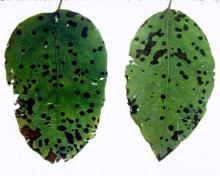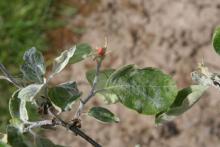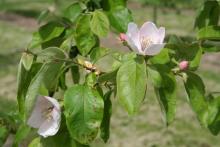See:
Hawthorn (Crataegus spp.) - Leaf Spot
Cause Diplocarpon mespili formerly Fabraea maculata (asexual: Entomosporium mespili), a fungus. Common in western Oregon and Washington on Cydonia sp. Other names include Fabraea leaf blight spot. Host range is wide including Asian pear, hawthorn, pear, photinia and serviceberry. Quince, some Asian pears and Asian hybrids are particularly susceptible, such as the Chinese cultivar Ya Li, while others are more resistant. Many ornamental pears, Pyrus calleryana, also get leaf spot.
The fungus overwinters in diseased leaves and shoots. Cool, wet weather favors disease development in the spring. Spores are disseminated by splashing water and need 8 to 12 hours of leaf wetness to infect leaves. Susceptibility does not seem to be reduced with leaf maturity.
Symptoms Reddish-purple spots develop on infected leaves. Centers of the spots become tan, and fungal sporulation (in acervuli) may be obvious in the center. Spots may also have a reddish halo. Badly affected leaves often drop early, and when the weather warms up and dries out, the new growth is rarely affected.
Cultural control
- Rake and destroy leaves in fall.
- Avoid overhead irrigation or apply such that plants are not wet for extended periods of time.
Chemical control Use in the spring during wet weather.
- Aprovia at 5.5 to 7 fl oz/A plus another fungicide and an adjuvant. Do not use within 30 days of harvest. Group 7 fungicide. 12-hr reentry.
- Bonide Fruit Tree and Plant Guard RTS is registered but also contains an insecticide in addition to a group 7 + 11 fungicide (see Pristine). Do not use within 21 days of harvest. H
- Cueva at 1 to 2 gal/A. May be used on day of harvest. Group M1 fungicide. 4-hr reentry. O
- Flint Extra at 2.5 to 2.9 fl oz/A. Use on a protectant schedule and not curatively. Do not use within 14 days of harvest. Injury may occur to Concord grapes if accidentally sprayed. Group 11 fungicide. 12-hr reentry.
- Inspire Super at 12 fl oz/A. Do not apply within 14 days of harvest. Group 3 + 9 fungicide. 12-hr reentry.
- Mancozeb (such as Dithane, Manzate, or Penncozeb) up to 6 lb/A prebloom or at 3 lb/A after bloom. Do not combine the 6 lb/A prebloom or the 3 lb/A all-season schedules. Do not apply within 77 days of harvest. See label restrictions. Group M3 fungicides. 24-hr reentry.
- Pristine at 14.5 to 18.5 oz/A. Do not use with thinning agents. The addition of a silicone-based surfactant has improved control. Can be used day of harvest. Group 7 + 11 fungicide. 12-hr reentry.
- Rhyme at 4 to 6 fl oz/A. Do not use within 14 days of harvest. Group 3 fungicide. 12-hr reentry.
- Scala SC at 7 to 10 fl oz/A alone or at 5 to 10 fl oz/A when tank-mixed with another fungicide. Do not apply within 72 days of harvest. Group 9 fungicide. 12-hr reentry.
- Sovran at 3.2 to 6.4 oz/A. Use as a protectant fungicide and not curatively. Do not use within 30 days of harvest. Injury may occur to some sweet cherries, such as 'Van', if accidentally sprayed. Group 11 fungicide. 12-hr reentry.
- Tebucon 45 DF at 4 to 8 oz/A. Do not use within 75 days of harvest. Group 3 fungicides. 5-day reentry.
- Topguard SC at 13 fl oz/A. Do not use within 14 days of harvest. Group 3 fungicide. 12-hr reentry.
- Vangard WG at 5 oz/A alone (prebloom only) or at 3 to 5 oz/A when tank-mixed with another fungicide. May be applied day of harvest. Use early in the season when weather is cool. Group 9 fungicide. 12-hr reentry.
Reference Postman, J.D. 2012. Quince (Cydonia oblonga Mill.) center of origin provides sources of disease resistance. Acta Hort. (ISHS) 948:229-234.




